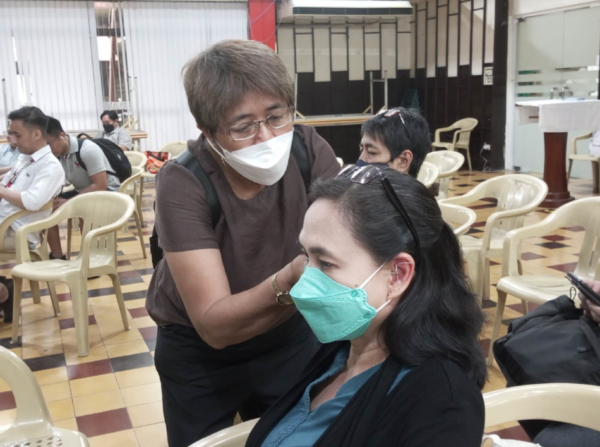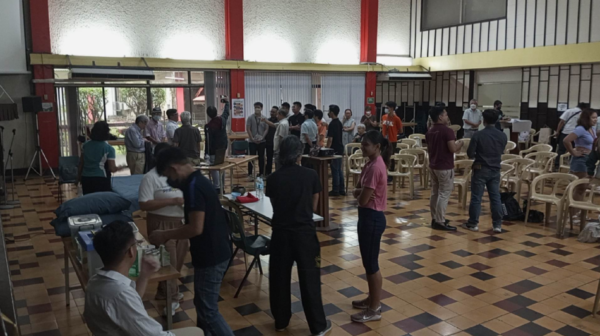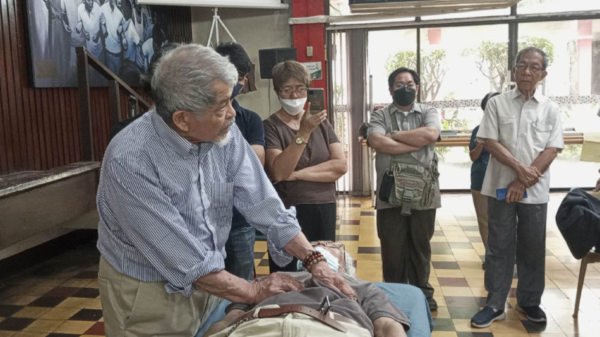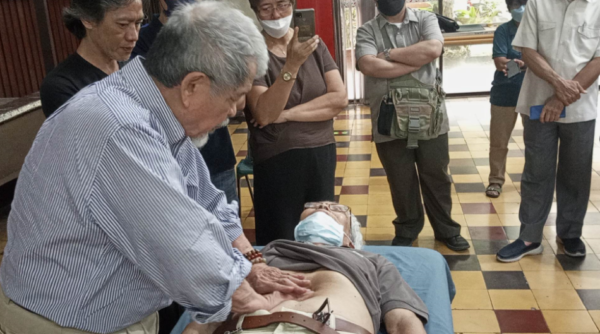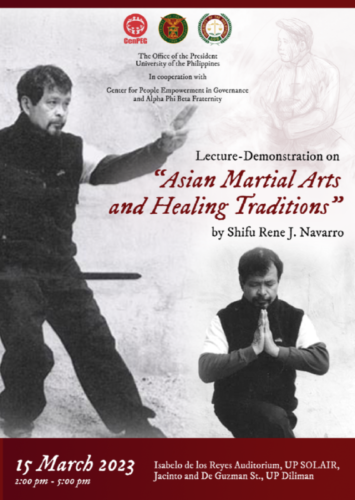Here is a copy of the the speech I prepared on the subject of eastern healing and martial arts on March 15, 2023 sponsored by the Office of the President of the University of the Philippines, in cooperation with the Alpha Phi Beta Fraternity and the Center for People Empowerment in Governance. I decided to extemporise instead when Annie Sollestre showed my work with INAM, the sponsor of my seminars since 1997, in a rather long Powerpoint Presentation. I told her not to do it but she did it anyway. I could not stop her because she had the remote and the mike. There was a Q&A segment that turned out to be a lively discussion. I demonstrated a couple of massage techniques and the INAM staff showed ear acupuncture on volunteers.
Journey Into Asian Healing Arts
By Rene J. Navarro
(Isabelo de los Reyes Auditorium, SOLAIR, UP Campus, Diliman, Quezon City, Philippines, March 15, 2023)
I would like to thank the sponsors for this opportunity to talk about the healing tradition of the east – The Office of the president of the University, the Alpha Phi Beta Fraternity and the Center for People Empowerment in Governance.
At that age when a person like me is supposed to be concerned about Death and Dying, I have been asked to talk about the tradition of eastern healing. It’s a misnomer because the so-called eastern healing is not about healing but about living. After all, isn’t eastern healing really about living authentically? In essence, the focus is not so much on curing a disease as preventing it through a regimen of healthy practices, so-called yang-sheng or Nourishing Life regimen. They are really methods of Self-Cultivation. As the Nanjing: the Classic of Difficult Issues says, What’s the use of building a fortification when the enemy has already entered the gates, why dig a well when the patient is already dying from thirst?
Pardon me for adverting to my own journey. I guess it is unavoidable since my understanding of eastern medicine is linked with my slow discovery of its different branches and integrated nature.
In my own search for Asian culture in Manila, it was at first martial art that I encountered. In the early 60s I was kind of thrust into training in Japanese Wado karate when my brother Florante found a teacher in my hometown and passed on the knowledge to me. Later Johnny F. Chiuten, another student in the university, a prominent member of the Beta Sigma Fraternity and a martial art master, asked me to study with him. Still later, when he went back to his home in Bantayan Island, he recommended me to the former Fujian Temple monk, Lao Kim, jobless at the time, and the old man taught me privately for 6 years. I learned rare fist and weapons forms: staff, spear, sword, guandao, the hoe and the 5-sectional whip. At this point, I became exposed to more eastern disciplines. Through the recommendation of my Chinese godfather Chan Tek Lao, I went to Chinatown to study Yang style tai chi chuan with his cousin Chan Bun Te at the old Hua-Eng Club in Binondo. Later Chan shifu took me to enroll in a Tai chi chuan class taught by the Taiwanese master Lao Yun Hsiao.
Martial art is probably one of the most misunderstood of the healing arts. It is often asked, How can a discipline that entails hurting or killing somebody be a healing art? Yes, there are practitioners of the art who do not seem to go beyond the culture of machismo and bullying and pataasan ng ihi but properly taught, the exercises of martial art are health-giving, not only in a physical but also in an emotional and psychological and spiritual way. Most of the different martial arts practiced in China were or are part of the Buddhist and/or Taoist religions and contain deep philosophical and spiritual roots. The Buddhists have Shaolin and the Taoists have Wudang, temples where they observe their monastic rituals, develop compassion, pursue their potentials and study their scriptures along with their martial forms. Sadly, when the martial arts were taken from the monasteries, they were reduced to plain combat, without the philosophies and the sacred rituals and often without the healing methods.
Back in the 1950s, largely because of our colonial education and upbringing, the Philippines did not have much connection to or knowledge of our culture. It was as if we were exiled from our own traditions and country: we consciously or unconsciously tried to mimic American ways and become Americanized. In many ways we even despised our customs. We were also alienated from our Asian neighbors. I myself did not know much about Li-Po or Du-Fu until I heard Gustav Mahler’s Songs of the Earth/Das Lied Von Der Erde. I attended a Methodist Church, followed its rituals, believed the Bible and sang with the choir at the Sunday services. At one Good Friday, I was one of those who gave a sermon on the 7 Last Words in church. At the University chapel, during Reformation Sunday, I used to recite Martin Luther’s Here I Stand speech to the Diet of Worms. I believed in the Holy Trinity, the Virgin Mary, Christmas and the Resurrection of Jesus. Back when I was in high school, I did not know any martial art. No hint of karate or kungfu. Like many kids, I played basketball, and admired its famous players, I danced boogie and rock and roll. Believe it or not, when I was 14 or 15, there was a sports instructor who made a big group of us dance boogie while we were wearing cowboy outfits at an athletic meet. In college I was into Hemingway, Shakespeare, Homer, Dylan Thomas, TS Eliot and like a lot of intellectuals, I followed the western canon. I wrote in English, I joined oratorical and writing contests in English and won awards, I spoke and read English in the classroom and outside. I went to the Jefferson Library on the Escolta and the British Reading Room on Azcarraga Street for their books and readings. When I saw pictures of Hatha yoga postures, I thought they were weird. I was a perfect colonial!
It was when I went to the US in late 1970 that I encountered eastern training courses. Irony of ironies, for the first time, I started learning arnis de mano, a style of Philippine stickfighting called Arnis Lanada, with a young Filipino master Amante “Mat” Marinas in Elmhurst, Queens, NY, Archie Bunker country, and was certified as an instructor. At the avant garde LaMama ETC in the Bowery, as a member of a theatre group called Philippine Educational Theatre Arts League (PETAL) organized and directed by Cecille Guidote, I learned Philippine indigenous dances of southern and northern Philippines. I performed on stage as an Ifugao warrior wearing a colorful loincloth. I was the escort carrying the umbrella of the Muslim princess dancing the Singkil. I translated several poems from the book “Isang Dipang Langit” by poet laureate Amado Hernandez, among them the Tagalog prison poem “Kung Tuyo Na ang Luha Mo, Aking Bayan”.
I became passionate about learning the culture of Asia. For a period of time I wrote haiku every day. I read the poetry and life of Basho and Li Bai and the fu/prose poems of China. I studied Wu style Tai chi chuan with Master Leung Shum in Manhattan. I went to China to train in Wu-Shu in Chengdu, Sichuan Province in 1983; among the styles I learned was Monkey Boxing with the famous Xiao Yingpeng known as Monkey King, after Sun Wukong, the character in the epic Journey to the West that took me two years to read; I also studied the Northern sword and spear and Hsing-I/Body-Mind Boxing. I encountered for the first time qigong or chi-kung, postures and movements which are a way of healing with energy. Qigong literally means the development of chi and is a comprehensive discipline. It includes different approaches such as growing one’s energy, both sexual and lifeforce, refining one’s emotions, channeling chi from outside, projecting chi to a person or group of persons, strengthening certain parts of the body like the organs, tendons and the bones, or developing one’s shen or spirit.
One summer in the early 80s I was in NY city and found the two books of Master Mantak Chia of the Healing Tao. One was a book on Taoist meditation entitled Awaken Healing Energy which was an instructional manual on the Microcosmic Orbit, Xiao Tian Zhou or Small Heavenly Circle; the other was a text on sexology, euphemistically called the Art of the Bedchamber. Meditation and Sexology are of course two of the 12 healing modalities in Chinese medicine. Like martial arts, sexology is a misunderstood healing modality. Sexology from the Taoist perspective is the cultivation, preservation and refinement of sexual energy for healing, longevity and spiritual discipline and growth. Through its practices, women could stop menstruation and muster their hormonal cycle into energy and men could control ejaculation and their emotions. There’s Single Cultivation, the nurturing and transformation of jing or sexual energy into lifeforce and shen or spirit. Then there’s Dual Cultivation, the paired work to combine and transmute raw sexual energy between Yin and Yang through manipulation of Jing and the copulation of male and female in certain positions and techniques.
I attended week-long retreats and then trained and got certified as an instructor. (I was also chosen as Instructor of the Year 1989.) Eventually I became Master Chia’s assistant and wrote and/or edited four of his books on neidan/internal alchemy (Enlightenment of Kan/Water ad Li/Fire) and two on healing (Taoyin and Chi Nei Tsang internal organs massage). The alchemy of Fire and Water was a secret transmission from Yi Eng, a Breatharian hermit from Central China, to Mantak Chia in Hongkong and was being taught for the first time in the west. I studied different healing, meditative, shamanic and spiritual methods. It was not enough. When I returned to the Philippines after February of 1986 I studied Lapunti Arnis de Abanico in Cebu and was certified as an instructor. Johnny Chiuten, my teacher in Dragon Tiger Fujian Temple Kungfu, and I made a documentary film of the style on Mactan Island. Johnny took me around to meet arnis de mano masters, including the legendary Guiling Tinga of Bantayan Island. I observed Philippine healers in Cebu, Manila, Baguio and Mount Banahaw.
It was a serious way of intensive immersion in Asian culture. Perhaps it was a kind of rebellion against colonialism and the legacy of a western lifestyle. Perhaps I was making up for lost time or trying to get rid of my colonial life or finding a Filipino identity that was encrusted with centuries of meretricious western influences, I cannot really say, but I had a great thirst for Asian traditions that could not be quenched, I just wanted more and more. And learning Chinese culture was like resurrecting my family’s Chinese past that was obliterated by Spain and the US.
I gave up my work in legal services representing indigent clients and retired my license as a member of the New York Bar. Something else happened in my life at about this time in late 1980s: For decades, I had been training my hands in combat and learning the vulnerable points of the human body, and then the realization came to me: Why should I spend my life learning how to fight when I can actually learn how to heal; I had two children whom I might hit in a fit of distemper and it worried and scared me. I stopped training in the deadly aspect of martial art and pursued the life of a healer. I also studied the more spiritual methods of Taoism: the mystical pursuit of alchemy/neidan and the development of virtues, love and compassion.
In 1989 I moved to Boston and for 3 years studied Chinese and Japanese acupuncture at the New England School of Acupuncture. I passed the national exams, got certified as a diplomate in acupuncture by the NCCAOM and licensed in Massachusetts. For another 3 years I studied traditional Chinese herbology at NESA. During the 10 years I lived in Boston I also studied the full fist and weapons curriculum of Classical Yang Family Tai chi chuan, this most gentle of Taoist arts that emphasizes softness and yielding and the mystical Qi, at the Gin Soon Tai Chi Federation. I became faculty for NESA and as a senior instructor of the Healing Tao (now Universal Healing Tao), pioneered a course in Inner Smile, 6 Healing Sounds, Microcosmic Orbit, a meditation on the 12 regular meridians, Buddha Palm Qigong and Tai Chi Chi Kung. I apprenticed to the Japanese sensei Kiiko Matsumoto and became her “moxa boy” applying and burning thread -like and sesame-size moxa on the indicated acupuncture points of her patients. I studied Pangu Shengong Qigong with Master Ou Wen Wei. I taught seminars in eastern healing arts in the US, UK, Cyprus, Egypt, The Netherlands, Philippines, and Thailand. I read the translations of The Mahabharata and the Bhagavad Gita, Dao De Jing, Zhuangzi, Yijing, Upanishads, Sunzi’s The Art of War, the Yoga Sutras of Patanjali, the Philippine epics Aliguyon and Lam-Ang and built a library of eastern books, DVDs and CDs. I listened to chants of the Heart and Diamond Sutra and Upanishads on CDs and online.
My life revolved around eastern culture and healing since then. I took lessons in Thai massage in Chiangmai, a few with the famous master Chaiyuth Priyasith at the millennium. Later, I studied Lei Shan Dao/Thunder Path with David Verdesi in Indonesia, Thailand, Istanbul, Rome and China. (David became the subject of the documentary “Superhumans” emceed by my friend, the famous Qigong master Lee Holden.) He introduced me to the Magus of Java in 2006 and the hermits of Huangshan in 2007, rare masters who could emit electricity from their hands, great healers all, and David and I sat at the feet of Hindu priests in Bali in 2012. While teaching English as a Second Language in Hangzhou, China in 2010, I took courses in Chinese calligraphy, this meditative discipline that is considered one of the 3 Perfections in China. I followed the seminars of Taoist priest Jeffrey Yuen through Maryland, Massachusetts, New Jersey and North Carolina and online. It was, well, immersion in eastern healing arts with a vengeance!
*** What, after all these
peregrinations, did I learn? I saw the different aspects of the human being —
Physical, Intellectual/Mental, 3 Souls/Shen, the 7 Spirits/Ling, Qi, Meridians, Yin-Yang, 5
Elements or Phases, Correspondences (in Hermetic terms: as above, so below; as below,
so above), karma (an influence possibly from the Buddhist) and Interface with
the World (what the Vietnamese Buddhist monk Thich Nhat Hanh calls inter-being
in his commentary on the Heart Sutra).
It is important to know what constitutes the human being. Look at the western
paradigm and compare it with the eastern. That is a good start for the process
of de-colonization. As you can see from the list of what the human is composed
of, there is so much more we have, more than just the Cartesian Body-Mind or
the New Age Body, Mind and Spirit. In the eastern perspective, we are holistic
in our view of the human being and in the way we live.
There are different approaches and choices to address different aspects of the
human being. We have:
Meditation (The Art of Silence/Stillness)
Qigong (The Art of Self-Cultivation)
Martial arts (The Art of movement, empowerment, strategy and tactic, and survival)
Dietetics/Nutrition (The Art of Nourishment)
Massage (The Art of Tuina, Shiatsu, dieda/traumatology, Chi Nei Tsang)
Internal Alchemy/Neidan (The Art of Fire and Water, Yin and Yang, 5 Elements)
Sexology (The Art of the Bedchamber and transmutation of Jing, Qi and Shen)
Feng-shui (The Art of the
Geomancy and the Earth)
Astrology (The Influences of the Stars and Planets)
Crystals, Minerals and Stones (Essence of the Earth)
Essential oils and Aromatherapy (Essence of Plants)
Herbs (Essence of Nature)
Acupuncture (The Art of
the Needle)
Which healing modality or
modalities are appropriate for a problem or the time of your life? These practices and modalities address
the different aspects of the human being. These are methods of healing but they
are also methods of living and are so much more varied than just working,
eating and the pursuit of happiness (which we often seek in the wrong places). They
show a road to a life that is much richer and satisfying and authentic.
Martial art is not just fighting. There’s empowerment for one, and wellness and self-discovery and the experience of Stillness and going to the Source. It brings us to the classics of warfare like Sunzi and Mao and how different they are from the shock and awe methods we’ve read about and seen in the west.
I learned the precepts of Sunzi, among them that the highest type of victory is not in winning a war but winning without fighting. The study of acupuncture gives us a picture of the human being as a grid of energy that mimics the universe; there are currents of Qi that run through the body. Qigong offers a connection to ourselves and to the earth and a regimen that can transform the Human Body and its different aspects in pursuit of longevity and perhaps immortality. Alchemy takes us on a search for transformation and, guided by the Yijing/the Book of Change, the Dao De Jing and the Zhuangzi, we reconcile and dissolve the polarities and dualisms in being human in the world and give birth to a new spirit that could span the length of the universe. It is difficult, perhaps impossible, to imagine it but it happens.
In a culture that has been variously called “colonial,” “hybrid,” “westernized,” even the deprecatory “mongrel,” where Philippine history has been dismissed as “300 years in a Catholic convent and 50 years in Hollywood,” it is refreshing when I come back here to see the appearance and development of modalities that are eastern in origin and orientation. When I began studying Chinese martial arts in the 60s, there were very few of us Filipinos who were serious students. Now when you go to the parks, you’ll see people practicing martial arts — arnis, kung-fu, karate — Asian combative arts. There are now practitioners of acupuncture and massage in clinics, spas, and centers of healing. Massage, for goodness’ sake, was something that was done in the dark alleys of T. Alonzo in Chinatown in the 60s. Where before only western doctors of allopathic medicine were allowed to practice acupuncture, there is now a government agency the Philippine Institute of Traditional and Alternative Health Care (PITAHC) that supervises and certifies practitioners of healing. I myself am now certified as a practitioner of acupuncture and Chinese medicine.
The thing is that we do not transform overnight. Change comes gradually, unpredictably. It should happen not only in the mind but in life: what you do every day as part of your routine, how you follow the seasons and the phases of the moon, with your diet and your activities. You do not usually “discover” your Path; you make it yourself. You do not discover your identity either; you partly create it and partly find it and then it keeps transforming itself in surprising and varied ways.
It took India and China thousands of years to develop their cultures. They borrowed from each other and from other countries. When I was in Chiangmai at the millennium, there were Filipino women who were also studying Thai massage. Now in 2023 I can see Thai massage being offered in different healing centers around the country. When I saw yoga in the 1950s I thought it was weird; now it is being done in different venues. Where before Chinese martial arts were taught in Binondo, they are now being shared in different schools and parks all over the country. There are Buddhist, Taoist, Kabbalah, Confucian, Hindu centers. Eventually, all this will play a role in the creation of a culture that is our own. Even now, I can see people talking about integrated healing modalities. Not only western but also eastern healing, not only acupuncture but also herbalism and massage and tai chi. We had Acupuncture Therapeutics Research Center (ATRC) before; it offered acupuncture treatments back in the 80s and 90s; now it is called INAM or Integrative Medicine for Alternative Healthcare Systems, with emphasis on INTEGRATIVE and it has massage, qigong, Tai chi, acupuncture and different yangsheng/Nourishing Life services. It is the NGO, a non-profit, that I’ve worked with since 1997, twenty-five years ago.
We haven’t really come full circle but we’re getting close. There are so many methods one could pursue that will open for us a rich engagement with the world at different stages of one’s life. The eastern traditions speak of the cycles of life and the different practices at different times in life. The Huangdi Neijing, the Yellow Emperor’s Classic of Internal Medicine, speaks of a cycle of 7 for women and 8 for men. I myself, at my age (82) have focused on the arts of the bardo or in-between and Transcendence for the last 10-15 years. When you reach 60 or 70 you are supposed to pursue a spiritual goal, leave your home and perhaps stay in a monastery or a temple or follow the life of a wanderer. I know it may sound morbid to some people, but I have asked the ancient riddle of my own mortality. What do you do as you reach the end of your life? There are the yoga of Dream and Sleep and the yoga of Death and Dying: they are actually also forms of eastern healing. So you’ve lived a full life, you’ve followed a career or your destiny on earth, as it is supposed to be written in the Akashic Records, and now what do you do? You see your body getting old or older. Your senses deteriorate along with the physical. Do you accept this as a natural process or do you persist in your denial of the inevitable? You also have choices now in your sunset years. I am happy that I have taught different healing modalities at INAM Philippines in the last 25 years. I’ve taught meditation, massage, qigong, acupuncture, tai chi chuan, Xing Shen Zhuang Fa, Xiao Tian Zhou, some alchemy, and shamanism. I have taught healers, masseurs and acupuncturists. We have students from as far as MIndanao and the Ilocos. We’ve taught women and men in the barangays of Samar, Homonhon, Victory Island and many regions of our country. We have taught children, victims of human trafficking, and blind masseurs. I know my students will carry on and teach what I have taught them. They will spread these teachings to the communities as we have done in many different parts of the country. That, ultimately, is much of what we leave behind.
Salamat po.
————–
© RN 2023
This text is based on the introduction to “Of Fire and Water” (forthcoming from Tambuli Media) and the remarks read by Rene J. Navarro at the Conference on the Integration of Traditional and Alternative Healing Arts sponsored by the Department of Health/PITAHC and the World Health Organization at Bayview Park Hotel on February 21-22, 2002. He holds a diploma in acupuncture and a certificate in Chinese herbology from the New England School of Acupuncture. Before his retirement he was licensed as an acupuncturist in Massachusetts and Hawaii. Now he is certified as an acupuncturist and practitioner of TCM in the Philippines. A graduate of the college of law, he became a member of the New York bar and worked as a lawyer for indigent clients.
Demonstrating a Chi Nei Tsang manipulation and ear acupuncture at the presentation in the University of the Philippines:
